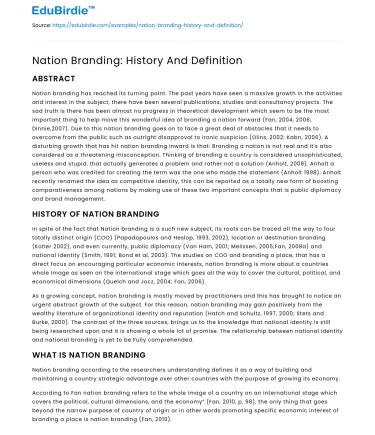ABSTRACT
Nation branding has reached its turning point. The past years have seen a massive growth in the activities and interest in the subject, there have been several publications, studies and consultancy projects. The sad truth is there has been almost no progress in theoretical development which seem to be the most important thing to help move this wonderful idea of branding a nation forward (Fan, 2004, 2006; Dinnie,2007). Due to this nation branding goes on to face a great deal of obstacles that it needs to overcome from the public such as outright disapproval to ironic suspicion (Olins, 2002; Kabn, 2006). A disturbing growth that has hit nation branding inward is that: Branding a nation is not real and it’s also considered as a threatening misconception. Thinking of branding a country is considered unsophisticated, useless and stupid, that actually generates a problem and rather not a solution (Anholt, 2008). Anholt a person who was credited for creating the term was the one who made the statement (Anholt 1998). Anholt recently renamed the idea as competitive identity, this can be reported as a totally new form of boosting comparativeness among nations by making use of these two important concepts that is public diplomacy and brand management.
HISTORY OF NATION BRANDING
In spite of the fact that Nation branding is a such new subject, its roots can be traced all the way to four totally distinct origin (COO) (Papadopoulos and Heslop, 1993, 2002), location or destination branding (Kotler 2002), and even currently, public diplomacy (Van Ham, 2001; Melissen, 2005;Fan, 2008a) and national identity (Smith, 1991; Bond et al, 2003). The studies on COO and branding a place, that has a direct focus on encouraging particular economic interests, nation branding is more about a countries whole image as seen on the international stage which goes all the way to cover the cultural, political, and economical dimensions (Quelch and Jocz, 2004; Fan, 2006).
Save your time!
We can take care of your essay
- Proper editing and formatting
- Free revision, title page, and bibliography
- Flexible prices and money-back guarantee
As a growing concept, nation branding is mostly moved by practitioners and this has brought to notice an urgent abstract growth of the subject. For this reason, nation branding may gain positively from the wealthy literature of organizational identity and reputation (Hatch and Schultz, 1997, 2000; Stets and Burke, 2000). The contrast of the three sources, brings us to the knowledge that national identity is still being researched upon and it is showing a whole lot of promise. The relationship between national identity and national branding is yet to be Fully comprehended.
WHAT IS NATION BRANDING
Nation branding according to the researchers understanding defines it as a way of building and maintaining a country strategic advantage over other countries with the purpose of growing its economy.
According to Fan nation branding refers to the whole image of a country on an international stage which covers the political, cultural dimensions, and the economy” (Fan, 2010, p. 98), the only thing that goes beyond the narrow purpose of country of origin or in other words promoting specific economic interest of branding a place is nation branding (Fan, 2010).
As an interest of area that is strongly gaining grounds, branding a nation or nation branding is moved in a large scale by practitioners, therefore making it an urgent need for theoretical and conceptual development of this subject” (Fan, 2010). Branding a nation takes into consideration the said country’s positioning, image, and reputation, and this can be compared to co-operate branding (Gilmore, 2002; Teslik, 2007; Roth and Diamantopoulos, 2009). Branding a nation can be a vital tool that can be used to develop and also keep a countries soft power. A victorious nation branding campaign can aid bring to life a positive image among international public, and this still goes ahead to increase the country’s soft power (Nye, 2004a, b; Fan, 2007, 2008a).
One can easily compare nation branding to national identity. Nation branding have to be strongly embedded in the realism and importance of the country relative to the ordinary creating of brand agency (Skinner and Kubacki, 2007).






 Stuck on your essay?
Stuck on your essay?

